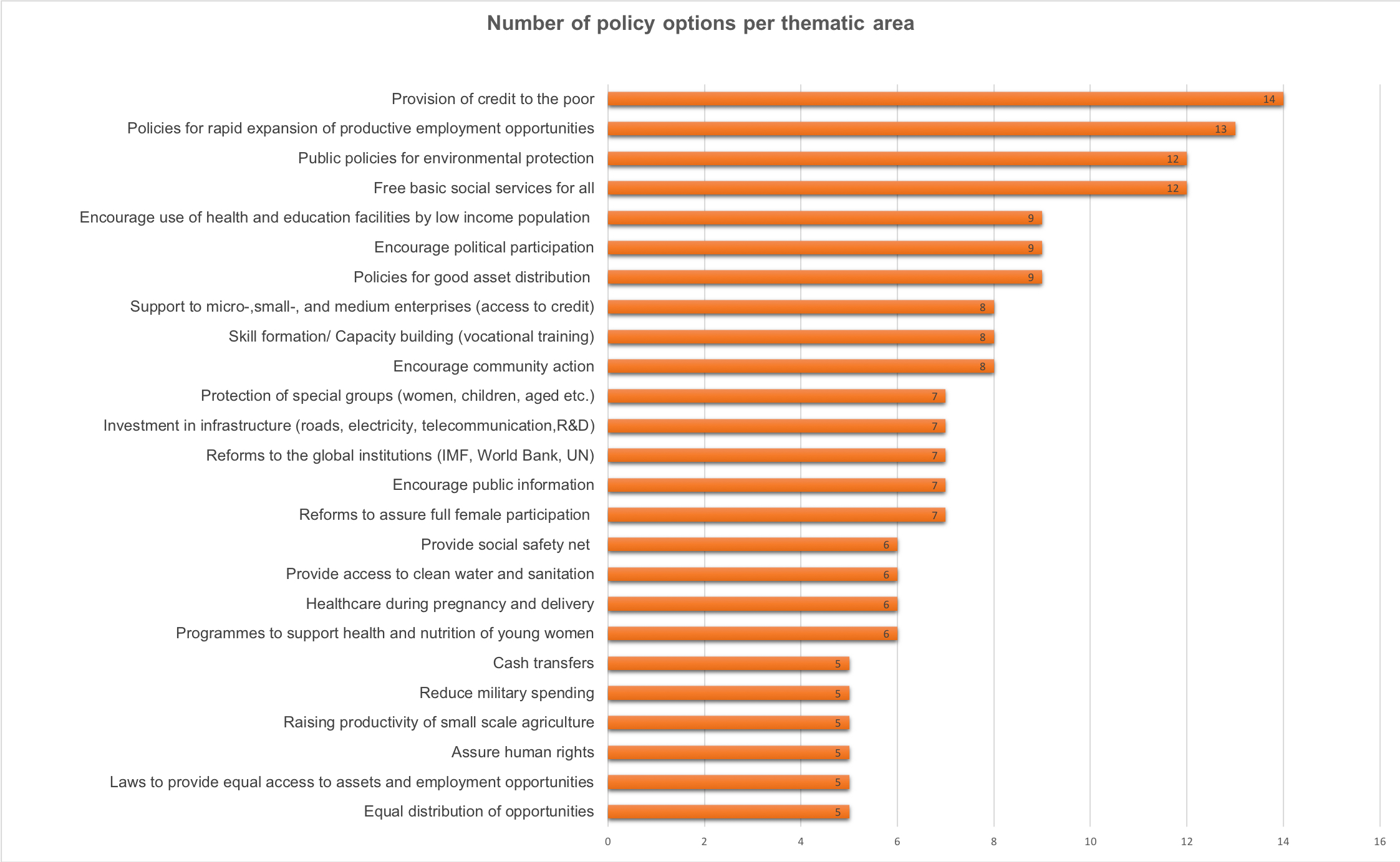In the proliferating landscape of development reports, many have asked the question of the value-added of the Human Development Reports (HDRs) in the era of the sustainable development goals (SDGs). The HDRs contribute to three crucial dimensions: conceptual work, measurement and data analysis, and policy options. The HDR Occasional Paper ‘Policies for Human Development’ takes a deep dive into the third dimension, analyzing in how far the concept of human development has influenced the HDRs’ policy options. In doing so it addresses the question of what distinguishes the HDRs’ policy recommendations from others and identifies their contribution to thought-leadership in development studies.
In a stocktaking exercise, the paper reviews the recommendations of 23 global HDRs, observing two patterns:
|
Regarding the first point, the central suggestion that is most frequently repeated in the HDRs is directly taken out of Amartya Sen’s human development approach: to enlarge peoples’ choices and freedoms to enhance their capabilities. The broadness of this guideline leaves policymakers much room to develop policies that are appropriate for the local context and account to national development priorities.
In addition to broad policy guidelines, the HDRs have also proposed around 200 specific policy options since the launch of the first report in 1990. At first sight, some of these policy recommendations do not appear very different from what other institutions that strive for equitable and sustainable development recommend. But an important distinction to make is that - in line with the HD paradigm - most of these recommendations aim at empowering people instead of conceiving them as mere beneficiaries of such policies.
The most frequent recommendations include “providing credit to the poor,” “policies for rapid expansion of productive employment opportunities,” “providing free basic social services,” “public policies for environmental protection,” “encourage political participation,” “policies for good asset distribution,” and “encourage the use of health and education facilities by low-income people”. The figure below shows the number of reports in which each policy was recommended. A complete list of all recommendations can be found in the Occasional Paper.

If the HDRs’ specific policy recommendations are not always unique to the HD approach, what value do they add, particularly in the context of the SDGs? Three points are worth highlighting.
- The HDRs’ policy advice has been conceptually very strongly linked to development approaches reflected in the SGDs, which is not necessarily the case with other reports. In alignment with the human development approach, the SDGs are based on the principle that development implies much more than economic growth, especially when aiming to make it sustainable for generations to come. They embrace the principle of universalism with their catchy phrase that ‘no-one should be left behind’. They are intended to represent a shared vision of development, aiming towards a space in which all human beings can develop their full potential without compromising on opportunities of future generations. The holistic definition, the emphasis on sustainability, and the principle of universalism - but also the fact that both, the HDRs and the SDGs measure achievements - constitute a common ground for both endeavours. The SDGs consist of a fixed set of goals and targets, while Tthe HD approach is deliberately open ended . The HDRs thus do not have a “natural finishing line” but can help policy makers in charting pathways towards the goals. The reports will continuously analyse opportunities and people-centred achievements and will continue to do so beyond 2030. This leads us to the second value that they can add to development thinking.
- The HDRs are open and flexible towards new and emerging issues. Each report picks up a specific topic that is currently relevant for international development and makes it the leitmotif for the analysis of human development around the world. Other UN agencies may also have a strong conceptual link to the SDGs, but they are committed to specific population groups or to specific topics. The HDRs can flexibly pick up relevant emerging issues for a certain year’s report topic and suggest innovative policy options directed towards any population group.
- Finally, the global HDRs can draw from numerous national and regional HDRs, of which the team working on the global reports forms part of the review process. This way, there is access to disaggregated data and best policy practices based on the experience of developing countries, that can then be advocated globally.
To sum up, the stocktaking exercise of the Occasional Paper shows that the HDRs’ broad policy guidelines are directly derived from the human development paradigm. Even though some are similar to those emitted by other development reports, the HDRs still have three crucial comparative advantages. They are closely aligned with the SDGs, they are flexible to take up newly emerging issues without being bound to a certain topic or population group, and they can draw from national and regional HDRs to gather, compare, assess and promote best policy practices among developing countries.
The HDialogue blog is a platform for debate and discussion. Posts reflect the views of respective authors in their individual capacities and not the views of UNDP/HDRO.
HDRO encourages reflections on the HDialogue contributions. The office posts comments that supports a constructive dialogue on policy options for advancing human development and are formulated respectful of other, potentially differing views. The office reserves the right to contain contributions that appear divisive.


